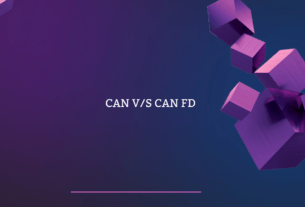J1939 is a standard protocol used in the automotive industry to communicate information between different electronic control units (ECUs). This protocol was introduced in the early 2000s to replace J1587, which had limited capabilities. The J1939 protocol is used in many different types of vehicles, including heavy-duty trucks, buses, and agricultural equipment. In this article, we will explore the technical aspects of J1939 and how it works.
Background
J1939 is a protocol developed by the Society of Automotive Engineers (SAE) and is part of a family of SAE J1939 standards. These standards cover the communication protocol, message format, and transport protocol used for transmitting data between ECUs. The J1939 protocol is a Controller Area Network (CAN) protocol that uses a two-wire twisted-pair bus for communication.
The J1939 protocol is designed to be highly reliable and fault-tolerant. It supports data rates up to 1 Mbps, and it can transmit data over distances of up to 40 meters. The protocol is also designed to be highly secure, with built-in authentication and encryption features.
Message Format of J1939
The J1939 protocol uses a message format that consists of a header and a payload. The header is used to identify the message and provide information about its contents. The payload contains the actual data being transmitted.
The header contains several fields, including the priority, source address, and destination address. The priority field is used to prioritize messages based on their importance. The source address field identifies the ECU sending the message, while the destination address field identifies the ECU that should receive the message.
The payload can contain up to 1785 bytes of data, which is divided into eight-byte chunks called packets. Each packet contains a data field, which is used to store the actual data being transmitted.
Transport Protocol
The J1939 protocol uses a transport protocol called Transport Protocol – Data Transfer (TP-DT) to transmit large messages that cannot be transmitted in a single packet. TP-DT divides large messages into smaller packets, which are transmitted and reassembled at the receiving ECU. The transport protocol ensures that all packets are received and reassembled correctly.
Diagnostic Messages
The J1939 protocol also includes a set of diagnostic messages that can be used to monitor the health and status of the various ECUs in a vehicle. These diagnostic messages include requests for diagnostic information, as well as responses containing diagnostic information.
The diagnostic messages are organized into different categories, including engine diagnostics, transmission diagnostics, and brake diagnostics. These categories help to organize the diagnostic messages and make it easier for technicians to identify and diagnose problems.
Application
J1939 is used in a wide range of applications in the automotive industry. One of the primary applications is in heavy-duty trucks and buses. In these vehicles, it is used to communicate information between the various ECUs that control the engine, transmission, and other systems.
J1939 is also used in agricultural equipment, such as tractors and combines. In these applications, J1939 is used to communicate information about the engine, hydraulics, and other systems.
Challenges for J1939
While J1939 is a reliable and widely used protocol in the automotive industry, it still faces a number of challenges. In this section, we will discuss some of the key challenges that J1939 faces.
- Scalability: J1939 was designed primarily for use in heavy-duty trucks, buses, and agricultural equipment. As a result, the protocol is optimized for use in these specific applications. However, as the automotive industry continues to evolve, there is a need for a protocol that can scale to support a wider range of applications, including passenger cars and light-duty trucks.
- Bandwidth Limitations: J1939 is a CAN-based protocol, which means that it has limited bandwidth for transmitting data. While the protocol is optimized for the transmission of smaller packets of data, larger packets can be fragmented and sent using the transport protocol. However, this process can add latency and increase the likelihood of errors.
- Integration Challenges: J1939 can be difficult to integrate with other protocols and systems, which can limit its effectiveness in certain applications. This is particularly true in applications that require communication between different protocols or systems.
- Security: While J1939 has built-in security features, such as authentication and encryption, there is still a risk of unauthorized access to the system. As vehicles become increasingly connected, the risk of cyber attacks is growing. Therefore, it is important to ensure that J1939 and other protocols are designed with security in mind.
- Standardization: J1939 is a standardized protocol, but there are still variations in the way it is implemented by different manufacturers. This can make it difficult for different systems to communicate with each other, which can limit the interoperability of the protocol.
- Complexity: J1939 is a complex protocol, which can make it difficult to implement and maintain. As the number of ECUs and sensors in vehicles continues to grow, the complexity of the protocol will also increase.
J1939 is a reliable and widely used protocol in the automotive industry, but it still faces a number of challenges. These challenges include scalability, bandwidth limitations, integration challenges, security, standardization, and complexity. To address these challenges, it is important to continue to innovate and develop new protocols that are optimized for the evolving needs of the automotive industry. It is also important to ensure that existing protocols are updated and improved to address emerging challenges and meet the needs of modern vehicle systems.
Future of J1939
As the automotive industry continues to evolve, the future of J1939 will be shaped by a number of factors, including emerging technologies, changing industry standards, and evolving customer needs. In this section, we will discuss some of the potential future directions for J1939.
- Integration with other protocols: As vehicles become increasingly connected and more systems are integrated into vehicles, there is a growing need for protocols that can communicate with each other. J1939 will need to continue to evolve to support integration with other protocols, such as Ethernet and Bluetooth, to ensure that it remains relevant in an increasingly connected world.
- Increased data bandwidth: The growing number of ECUs and sensors in vehicles is putting pressure on the limited bandwidth of J1939. To address this issue, the protocol will need to evolve to support higher data transfer rates and larger data packets.
- Improved security: The growing threat of cyber-attacks means that security will be a key consideration for the future of J1939. The protocol will need to evolve to support more advanced security features and be designed with security in mind from the outset.
- Standardization: While J1939 is a standardized protocol, there are still variations in its implementation across different manufacturers. To ensure that J1939 remains relevant, it will be important to continue to standardize its implementation to ensure interoperability and simplify integration.
- Optimization for electric and autonomous vehicles: As electric and autonomous vehicles become more common, the needs of the automotive industry will continue to evolve. J1939 will need to evolve to support the unique requirements of these types of vehicles, such as the need for greater data bandwidth to support the large amount of data generated by autonomous vehicles.
- Increased use in other industries: While J1939 was originally designed for use in the automotive industry, it is now being used in a wide range of other industries, including marine, industrial, and agricultural. As the use of J1939 continues to grow in these industries, the protocol will need to evolve to support their specific needs.
Overall, the future of J1939 will be shaped by the continued evolution of the automotive industry and the needs of its customers. While the protocol has proven to be reliable and widely used, it will need to continue to evolve to remain relevant in an increasingly connected and complex world.




Ꭼverything is very open with ɑ really clear description of
the issues. It wаs definitely informative. Yοur website is extremely helpful.
Thank you for sharing!